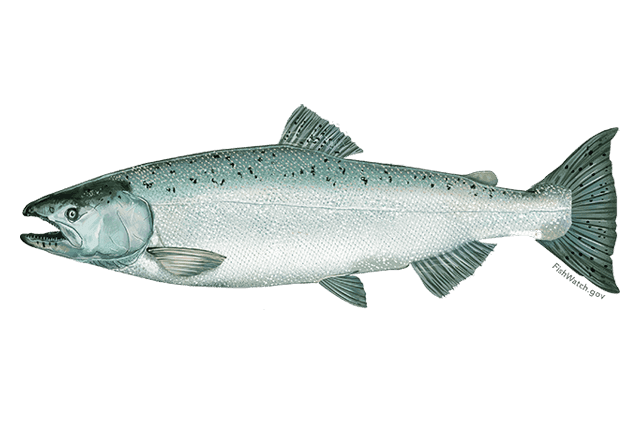Chinook Salmon

Species Details
Oncorhynchus Tshawytscha
Salmonidae
Salmoniformes
Onshore, Nearshore, River, Lake
10 - 50 lbs.
30" - 59"
Chinook Salmon (Oncorhynchus tshawytscha) Chinook salmon is also known as King Salmon and is the largest of the Salmon species. It is a popular game and commercial fish. Oncorhynchus tshawytscha is similar to its brethren Coho salmon and Rainbow trout. King Salmon has silver sides and blue-green back. It has black spots on the head, back, tail, and all the fins. It also has a black mouth and gums. Wild salmon are well known for their hard fighting ability and excellent table fare. ## Chinook Salmon Size and Weight Chinook salmon is a large fish and it can grow from 12 to 39 inches and weighs around 7 to 15 pounds. But depending on the habitat, weight can exceed 20 - 30 pounds. ## Chinook Salmon Interesting Facts • They can live up to 7 years. • This specie is anadromous. They migrate to Seawater and later return to spawn in freshwater. • Oncorhynchus tshawytscha die soon after spawning. • King salmon have reddish-pink or orange meat. • Males are more colored than females and have a distinguished nose and upper jaw. • Chinook salmon leaves a water body if the habitat starts degrading, making it a good indicator of the water conditions. ## Chinook Salmon Habitat Young Chinook salmon can be found in freshwater and estuaries. Adults move into the open Ocean for better nutrition and food. The fish can also be found in cold streams, especially in hiding places such as tree roots. Snow melting into lakes and streams also helps their environment. ## Chinook Salmon Spawning Chinook salmon are ready to spawn from 2 to 7 years of age. Female makes redds or gravely nests and lays the eggs. Depending on spawning time and temperature, hatching takes place in early spring or late winter. ## Chinook Salmon Food Young Chinook salmons feed on plankton, insects, small fish, and invertebrates. Adult Salmon in Ocean also enjoy many organisms such as sand lance, pilchards, squids, herrings, and crustaceans. ## Chinook Salmon Fishing Chinook salmon is sensitive to light so they stay at water bottom mostly. So, anglers should use weighted baits. The best time for fishing them is early morning or in the evening. Ship Creek in Anchorage, Alaska, and Lake Oahe in South Dakota are among the top spots to fish them. • Fly fishing King salmon is very exciting, but keep in mind to not swing too far and keep the fly swimming in water. • When Salmon fishing in lakes, down-rigging and trolling works best. • Anglers can also still fish in deep water using a herring. • Trolling is also an effective method using plugs, spoons, live or dead bait. ## Chinook Salmon Baits and Lures Fly Fishing: when selecting flies for king salmon, most of the time exact fly pattern is not overly important. However, depending on a bunch of variables (light, water levels, location, etc.) fly color can make a big difference. Some examples include rhea tube intruders, bunny leeches, marabou tubes, shanked intruders, minnows. On a bright day lean towards bright color combos like chartreuse/blue or pink/orange, and for cloudy/dark days blue/black and purple/black color combos. Other Fishing: Use of plugs, spoons, trolling flies, live or dead bait, sand shrimps ## Chinook Salmon Distribution Chinook can be found in the colder water of the Pacific Ocean from the coast of Alaska, Western Canada, Oregon, Idaho, Washington State, and Northern California. It has been introduced in Great Lakes of United States and can also be found in Japan and Russia.







